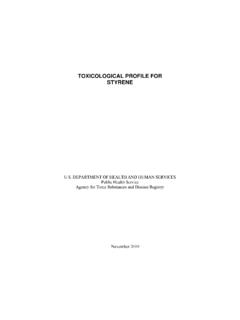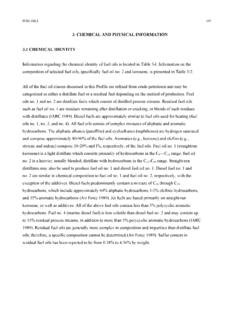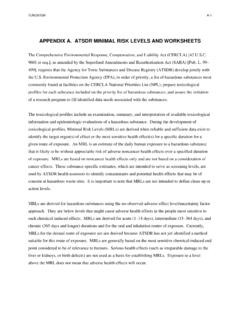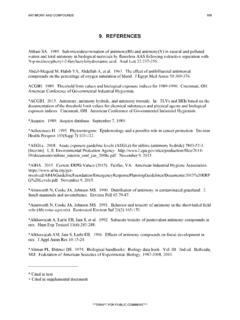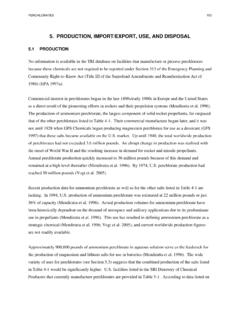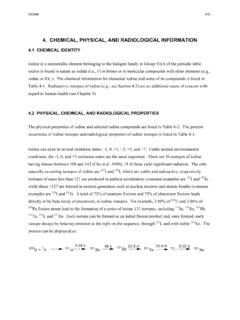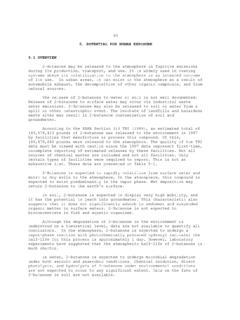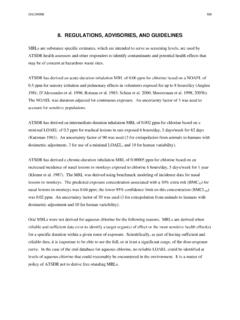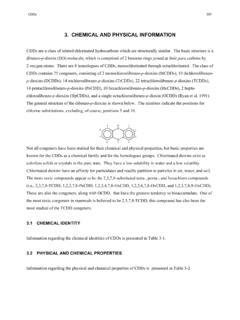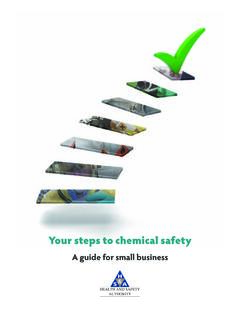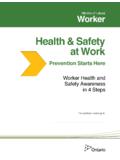Transcription of How to Reduce Your Exposure to Chemicals at Home, Work ...
1 Agency for Toxic Substances and Disease Registry Division of health Assessment and Consultation How to Reduce Your Exposure to Chemicals at Home, Work, and Play You come into contact with Chemicals every day. This is called chemical Exposure . Although some chemical exposures are safe, others are not. For you to become sick, a certain amount of a harmful chemical must enter your body. Harmful Chemicals can get into your body if you breathe, eat, or drink them or if they are absorbed through your skin. This booklet suggests ways you and your family can Reduce your Exposure to Chemicals at home, at work, and at play. CS214865-C 1 At Home If you are remodeling your home, do so safely. Find out if you have asbestos, mercury, or lead in your home before you start. Many counties require permits for remodeling. The permit office should offer help on how to safely remodel your home.
2 Your health department may test water or dust for lead. An inspection may also tell you if your house has hazardous materials. Removing hazardous materials requires special care and often special training and equipment. Learn how to handle, remove, and dispose of these materials safely, or hire professionals. Professionals have the right equipment, personal protective gear, and training to do the job safely. For asbestos, hire a professional contractor who specializes in asbestos removal. For mercury thermostats, hire a heating, ventilation, and air conditioning (HVAC) specialist. You should be aware of possible dangers in your house, including possible Exposure to Chemicals . You can do many things around your house to Reduce or prevent exposures to hazardous substances. Be Aware of Possible Dangers Around the House If your house was built before 1970, it may have been built with materials that contain asbestos, mercury, or lead.
3 Asbestos can be found in insulation, wiring, and roof or siding shingles. Mercury is frequently found in old thermostats and old light switches. Lead is sometimes found in old plumbing and paint. 2 3 At Home Use Cleaning Products Safely Many cleaning products give off fumes that you should not breathe in. Some can burn or irritate your skin and eyes. Most are poisonous if swallowed. To protect you and your family from harm, Make sure the room you are cleaning is well ventilated with a fan or an open window; Store your cleaning products in a safe place where your children cannot reach them; Keep cleaning products in their original containers; Do not mix cleaning products with one another; Follow the directions on the containers; and Clearly mark hazardous cleaners. To Reduce your Exposure , use natural cleaning products, such as vinegar (removes mildew and grease), lemon juice (stain remover, glass cleaner, and deodorizer), baking soda mixed with water (all-purpose cleaner), and olive oil (furniture polish).
4 If you are concerned about any products you bring into the home, look up potential health hazards at http:// At Home Heating Your Home Place heaters at least 16 inches from the walls, curtains, and furniture. Hot surfaces on the heater pose a fire If you use space heaters or wood burners in your home, you and burn risk. should be aware of these safety concerns. Never refuel indoors. Kerosene Heaters If you use a kerosene heater, ensure that your home has lots of circulating air, especially if your home is well insulated. If Wood-burning Fireplaces your kerosene heater is poorly maintained or not adjusted If you use a wood-burning fireplace, properly, it can release pollutants into your home. Some of Have your chimney checked for problems and cleaned these pollutants are regularly, and Carbon dioxide, Do not burn treated lumber in your fireplace.
5 This Carbon monoxide, and lumber can release toxic smoke when it burns. Soot. Other Heating Concerns Protect your family by taking the following steps. Never use gas ovens or burners to heat your home. Never Follow the instructions for your kerosene heater use barbecues or grills in the house, carport, or garage. carefully. Use only water-clear 1-K grade kerosene. Install carbon monoxide detectors inside your home. Leave a window cracked open and open the doors Carbon monoxide is an odorless, colorless, and toxic gas. between rooms. Gas from kerosene heaters or worn boilers and furnaces may cause high levels of carbon monoxide inside your home. Exposure to carbon monoxide can lead to health problems or even death. 4 At Home Working in the Garage If you work on cars, lawn mowers, snow blowers, or other types of small engines, you should find an auto shop or waste disposal location that will help you discard old oil.
6 Use kerosene, gas, and paint thinners with care. Keep these liquids in well-marked (preferably original) or DOT-approved containers and follow directions. Store Chemicals out of reach of children. When working with Chemicals , wear protective equipment such as a mask, gloves, or other appropriate clothing such as goggles and long pants. Do not idle your car in a closed garage or a garage attached to your house. Keep the garage doors open for a couple of minutes after you park your car. This step will help clear out the fumes (carbon monoxide) before you open the door to your house. 5 At Home Working in the Garden or Yard Chemicals , like pesticides, can pollute the soil. Polluted soil can affect the food you grow and eat. Polluted soil can also spread through the air as dust particles. When it rains, these dust particles may settle back into the soil.
7 If you live in an area that has contaminated soil and you want to garden, a raised-bed garden is one way to avoid exposing you and your family to Chemicals . In raised-bed gardening, you build boxes on top of the ground. These boxes separate your gardening soil from the contaminated soil. Use bagged soil or soil from a contaminant-free area to ensure your safety. Gardening can involve the use of herbicides, pesticides, and fertilizers. Below are some ways to help protect your health if you use these Chemicals . Have your soil tested before you fertilize. This service is offered for free from many Cooperative Extension Service offices. Calculate the correct amount of fertilizer, and do not apply right before or after heavy rainfall. Dampen the soil with water before you garden. This step will limit the amount of dust you inhale.
8 Take your shoes off at the door to avoid tracking soil into your home. Wash your hands after gardening. Wash fruits, vegetables, and herbs before you eat them. 6 At Work Many jobs might expose employees to hazardous materials, causing various health effects. Examples of workplace Exposure can be found in factories, chemical plants, manufacturing, and automotive shops. Reducing Your Exposure to Chemicals at Work If you may come into contact with hazardous Chemicals and materials at work, you can do things to Reduce your Exposure . Read and follow instructions provided by your employer. If you come into contact with dust, fibers, chemical fumes, radiation, or biologic agents on your job, ask for and wear all required personal protective equipment (such as gloves, masks, coveralls, and respirators). Shower or change clothes before leaving work.
9 Otherwise, you can carry contaminants home from work on your clothing. If your clothing is contaminated, wash your work clothes separately from the rest of your family s clothing. 7 At Play Many hobbies involve using Chemicals . For example, woodworking and painting use solvents, thinners, and finishes. Pottery can use a mix of Chemicals to create glazes, and some stained glass materials can contain lead. The Agency for Toxic Substances and Disease Registry (ATSDR), based in Atlanta, Georgia, is a federal public health agency of the Department of health and Human Services. ATSDR partners with communities across the nation to increase knowledge about toxic substances, Reduce the health effects of toxic exposures, and protect the public health . Reducing Your Exposure to Chemicals at Play If your hobby involves the use of Chemicals , you can Reduce your chances of Exposure in several ways.
10 Read the instructions for how to use the chemical properly. Keep the work area well ventilated. Wear gloves, masks, or other protective devices to Reduce contact with the Chemicals . Make sure you wash your hands with soap and warm water after using Chemicals . Investigate alternatives. If you like to do woodworking or refinishing, look into using the nontoxic wood strippers found in most hardware stores. At home, work, or play, you can Reduce your chances of chemical Exposure by being aware of your surroundings, reading labels and following instructions, and washing your hands often. If you are concerned about any products you bring into the home, look up potential health hazards at http:// If you have questions or want more information about Exposure to Chemicals or other environmental health topics, please visit the Agency for Toxic Substances and Disease Registry s Web site at Sources: Conant J, Fadem P.
